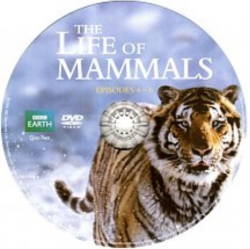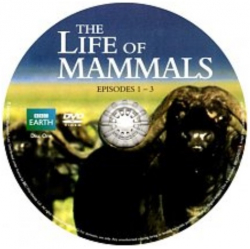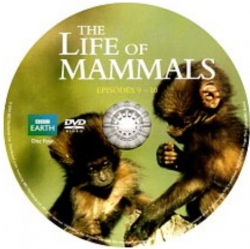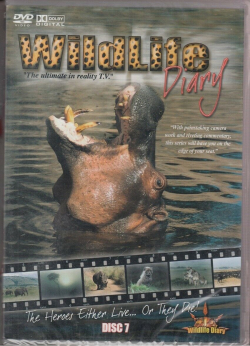Life of Mammals Disc 2

Type
Audio/Visual
Authors
Attenborough ( David )
Category
DVD - Episode/s of series
[ Browse Items ]
Publisher
BBC Earth, United Kingdom
Abstract
Three and a half million years separate the individual who left these footprints in the sands of Africa from the one who left them on the moon. A mere blink in the eye of evolution. Using his burgeoning intelligence, this most successful of all mammals has exploited the environment to produce food for an ever-increasing population. In spite of disasters when civilisations have over-reached themselves, that process has continued, indeed accelerated, even today. Now mankind is looking for food, not just on this planet but on others. Perhaps the time has now come to put that process into reverse. Instead of controlling the environment for the benefit of the population, perhaps it's time we control the population to allow the survival of the environment.
— David Attenborough, in closing
— David Attenborough, in closing
Description
Episode 4: The Chisellers
The fourth episode examines rodents, which are characterised by strong, sharp, continuously growing incisors. These enable the animals to eat food that others find impossible, such as nuts or wood, and have enabled them to become the most successful and numerous of all mammals. Attenborough visits the forests of Virginia, where the grey squirrels are able to differentiate between the acorns of the red oak and the white oak: eating the latter and storing the former. Seed-eaters can live almost anywhere, and the desert-dwelling kangaroo rat uses its cheek pouches to transport its supply back to its burrow. A family of beavers is shown in Wyoming. Their construction skills have enabled the building of a dam, which has given them a lake so they can safely swim and forage in the nearby woodland. Infrared cameras are installed in their lodge during winter and a pair of muskrats are revealed to be sharing it. Many rodents are nocturnal, and a porcupine is shown warning off a young leopard. The naked mole-rat is a burrower that, like bees and ants but unlike any other mammal, lives colonially with castes of individuals. Rats and mice are the largest group of rodents, comprising some 1,300 species. They reproduce rapidly: a female house mouse can become pregnant at five weeks old, and a plague of the creatures is shown exploiting a grain store. The South American mara has to eat grass on plains, but still nests in burrows. The world's largest rodent is the capybara, a semi-aquatic animal from South America.
Episode 5: Meat Eaters
This programme is devoted to carnivorous mammals. Attenborough starts in the English countryside, where, besides humans farming sheep, a stoat chases and catches a rabbit. Meat is one of the most energy-rich foods there is, and there are several groups that eat it exclusively. Among the most prolific to do so are cats and dogs. Canine adaptations are varied, and are illustrated by the differences between fennecs and Arctic foxes. Meanwhile, the biggest concentration of meat occurs on the plains of Africa, and African hunting dogs are shown capturing a wildebeest with efficient teamwork. However, the largest wild canid is the wolf, and Attenborough successfully communicates with a pack of them in North America before they embark on an exhausting hunt for elk. Back in Africa, infrared cameras are used to examine the nocturnal activities of lions, which bring down a zebra. During the day, a solitary cheetah — the fastest animal on four legs — swiftly overtakes an impala and despatches it. One of the most adaptable of the big cats is the leopard, and infrared technology is again used to spot one of them as it searches an Indian village for domestic goats. As it does so, it comes dangerously close to the hut where Attenborough sits with his observation equipment. Finally, Attenborough visits the frozen North to witness the animal kingdom's most powerful predator, the Siberian tiger, albeit one that is held in captivity.
Episode 6: The Opportunists
The next instalment deals with those mammals that are omnivorous. Attenborough goes to a zoo in Atlanta to see the giant panda. He contrasts its restrictive diet of bamboo with the less selective forms of nutrition favoured by other species. The raccoon is among the most successful: its sensitive hands and inquisitive nature have enabled it to become extremely adaptable. To the other extreme, one of the scarcest omnivores is the babirusa, a kind of pig found in Indonesia. A good sense of smell is vital for such creatures and wild boars have become expert foragers. Foxes have gained a reputation for killing more chickens than they need to: in fact they demonstrate foresight by burying surplus food to eat later. Skunks visit a cave of bats and cross a carpet of guano to seek out the young that fall from the ceiling. The most formidable opportunists are grizzly bears, and Attenborough observes them fishing for migrating salmon in Alaska. Their feeding habits in the lead up to hibernation are discussed in detail. The replacement of natural habitats by modern cities and the extravagance of their human occupants have provided a rich source of sustenance for many. Raccoons, bears and foxes have all become well adapted to an urban lifestyle. However, in this regard, it is the brown rat that has become most abundant. Finally, Attenborough points out that it is the opportunistic traits of humans that have enabled them to dominate the world.
(https://en.wikipedia.org/wiki/The_Life_of_Mammals)
The fourth episode examines rodents, which are characterised by strong, sharp, continuously growing incisors. These enable the animals to eat food that others find impossible, such as nuts or wood, and have enabled them to become the most successful and numerous of all mammals. Attenborough visits the forests of Virginia, where the grey squirrels are able to differentiate between the acorns of the red oak and the white oak: eating the latter and storing the former. Seed-eaters can live almost anywhere, and the desert-dwelling kangaroo rat uses its cheek pouches to transport its supply back to its burrow. A family of beavers is shown in Wyoming. Their construction skills have enabled the building of a dam, which has given them a lake so they can safely swim and forage in the nearby woodland. Infrared cameras are installed in their lodge during winter and a pair of muskrats are revealed to be sharing it. Many rodents are nocturnal, and a porcupine is shown warning off a young leopard. The naked mole-rat is a burrower that, like bees and ants but unlike any other mammal, lives colonially with castes of individuals. Rats and mice are the largest group of rodents, comprising some 1,300 species. They reproduce rapidly: a female house mouse can become pregnant at five weeks old, and a plague of the creatures is shown exploiting a grain store. The South American mara has to eat grass on plains, but still nests in burrows. The world's largest rodent is the capybara, a semi-aquatic animal from South America.
Episode 5: Meat Eaters
This programme is devoted to carnivorous mammals. Attenborough starts in the English countryside, where, besides humans farming sheep, a stoat chases and catches a rabbit. Meat is one of the most energy-rich foods there is, and there are several groups that eat it exclusively. Among the most prolific to do so are cats and dogs. Canine adaptations are varied, and are illustrated by the differences between fennecs and Arctic foxes. Meanwhile, the biggest concentration of meat occurs on the plains of Africa, and African hunting dogs are shown capturing a wildebeest with efficient teamwork. However, the largest wild canid is the wolf, and Attenborough successfully communicates with a pack of them in North America before they embark on an exhausting hunt for elk. Back in Africa, infrared cameras are used to examine the nocturnal activities of lions, which bring down a zebra. During the day, a solitary cheetah — the fastest animal on four legs — swiftly overtakes an impala and despatches it. One of the most adaptable of the big cats is the leopard, and infrared technology is again used to spot one of them as it searches an Indian village for domestic goats. As it does so, it comes dangerously close to the hut where Attenborough sits with his observation equipment. Finally, Attenborough visits the frozen North to witness the animal kingdom's most powerful predator, the Siberian tiger, albeit one that is held in captivity.
Episode 6: The Opportunists
The next instalment deals with those mammals that are omnivorous. Attenborough goes to a zoo in Atlanta to see the giant panda. He contrasts its restrictive diet of bamboo with the less selective forms of nutrition favoured by other species. The raccoon is among the most successful: its sensitive hands and inquisitive nature have enabled it to become extremely adaptable. To the other extreme, one of the scarcest omnivores is the babirusa, a kind of pig found in Indonesia. A good sense of smell is vital for such creatures and wild boars have become expert foragers. Foxes have gained a reputation for killing more chickens than they need to: in fact they demonstrate foresight by burying surplus food to eat later. Skunks visit a cave of bats and cross a carpet of guano to seek out the young that fall from the ceiling. The most formidable opportunists are grizzly bears, and Attenborough observes them fishing for migrating salmon in Alaska. Their feeding habits in the lead up to hibernation are discussed in detail. The replacement of natural habitats by modern cities and the extravagance of their human occupants have provided a rich source of sustenance for many. Raccoons, bears and foxes have all become well adapted to an urban lifestyle. However, in this regard, it is the brown rat that has become most abundant. Finally, Attenborough points out that it is the opportunistic traits of humans that have enabled them to dominate the world.
(https://en.wikipedia.org/wiki/The_Life_of_Mammals)
Number of Copies
1
| Library | Accession No | Call No | Copy No | Edition | Location | Availability |
|---|---|---|---|---|---|---|
| Main | 2146 | 1 | Yes |




